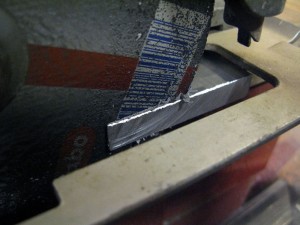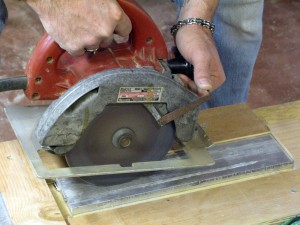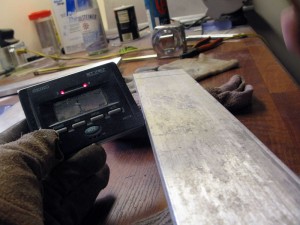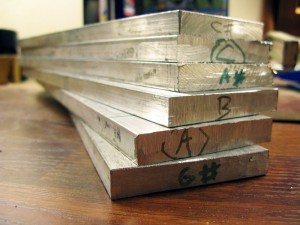 We bought some aluminum bar (3″ x .5″), viagra dosage which has a nice, viagra resonant tone without any nasty harmonics to it.
We bought some aluminum bar (3″ x .5″), viagra dosage which has a nice, viagra resonant tone without any nasty harmonics to it.
Also, medical it’s the lightest choice (brass and steel are MUCH heavier), which will become important when we have close to a hundred pounds of keys, steel framing and audio pickups hanging off the van.
I learned how to choose raw materials for this project eight years ago the first time I built a xylophone (this one), after downloading these instructions.
I spent a good deal of time hunkered down on my knees, balancing odd bits of aluminum, steel and brass on balled-up socks (per Jim Doble’s excellent instructions), whacking it and listening to it – which gets you stared at, but generally dismissed as not worth calling the cops on.
Eventually, you figure out what sounds best – and off you go.
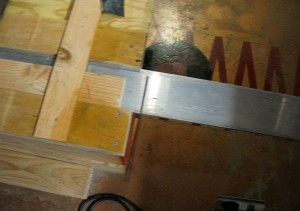 First I built a jig to hold the bar steady while cutting. I used a gutsy old Milwaukee circular saw I bought at a yard sale 15 years ago, fitted with a Type 1 cutting wheel.
First I built a jig to hold the bar steady while cutting. I used a gutsy old Milwaukee circular saw I bought at a yard sale 15 years ago, fitted with a Type 1 cutting wheel.
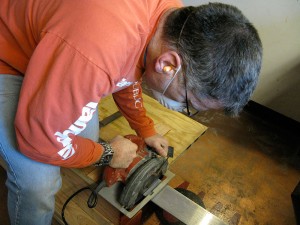 Each cut takes a good 10-15 minutes, which means I’m probably doing it wrong, but hey – this is how it worked before, and the xylophone sounds pretty nice.
Each cut takes a good 10-15 minutes, which means I’m probably doing it wrong, but hey – this is how it worked before, and the xylophone sounds pretty nice.
The real challenges – the parts of this project that we *don’t* know how to do yet, will be welding together the steel frame of the instruments that will let us bolt them to the van – and figuring out how to mike them for sound without picking up a lot of ambient playa noise.
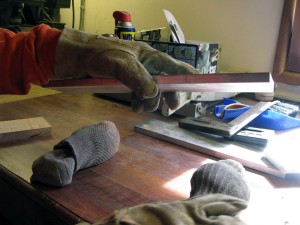 A couple of balled-up socks serve as a neutral cushion that lets the key ring freely when you whack it with a mallet. Later, we’ll drill holes in the precise dead spots, or “nodes” where the bar can be held in place without losing any of its resonance, but for now we need a quick-dirty test-bed for checking the tuning.
A couple of balled-up socks serve as a neutral cushion that lets the key ring freely when you whack it with a mallet. Later, we’ll drill holes in the precise dead spots, or “nodes” where the bar can be held in place without losing any of its resonance, but for now we need a quick-dirty test-bed for checking the tuning.
Testing the tone with a guitar tuner gives you an idea of how close you are to your target note (in this case A#/B-flat). If the note is flat, you can raise it by grinding or cutting the ends of the keys.
If the note is too sharp, you can lower it by gouging metal out from the underside of the key.
Ploonnnggggg. Poifect. But here’s an annoying phenomenon – heated up by grinding and gouging, the metal actually rings flatter than it will when it cools. So you have to set it aside to work on something else so it has time to cool a while before tuning it.
Today was brought to you by the notes G#, A, A#, B and C – a total of about 5 hours work (which including building the cutting jig and training my son to use the bench grinder (about which more tomorrow).

